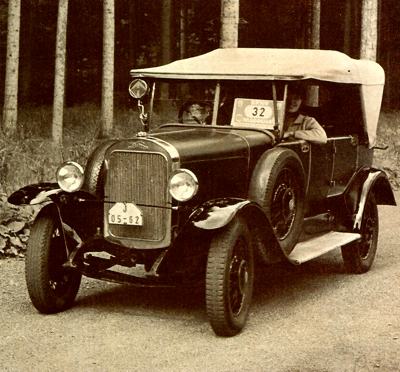|
Wanderer
|
1898
- 1936 |
Country: |
 |
|
Josef Walter
In 1898 Josef Walter began building motorcycles in Smichov, near Prague, Czechoslovakia, adding a bathchair-like three-wheeler to the range in 1908. At first the V-twin power units of these machines were of only 500cc capacity, but this was gradually increased to a more lethal 1250cc. Unusually, the rear axle was driven by shaft, not chain, and eventually closed four-seater coachwork was available on the tricycle chassis.
In 1912 came the firm's first real car, the WI, with a 14 hp four-cylinder engine; there was also a four-wheeled cyclecar with the 1250 cc V -twin engine, which achieved some sporting successes, including class wins at the Semmering, Riedsburg and Zbraslav-Jiloviste hillclimbs. The WI grew into the WIl, then the WIll, with increases in engine power and capacity; then after the Great War came the WZ, which had a 1540cc four-cylinder power unit.
Vitoz Kumpera
The WIZ sporting model of 1921 was broadly similar, except for its more powerful engine. In 1922 Joseph Waiter lost control of the factory and set up a new gear manufacturing works at Kosire near Prague. The firm was now headed by Vitoz Kumpera whose young son Teny, after spending some time with Peugeot, Hispano-Suiza and Gnome et Rhone, took over as general manager of Waiter in 1927.
Jindrich Knapp
In 1923 a new racing Waiter appeared with a 1945cc four-cylinder engine with a single overhead camshaft and a power output of 78 bhp. It could achieve over 100 mph in racing trim, and was generally driven by Jindrich Knapp, who was Waiter's principle racing driver throughout most of the marque's competition career. Walter cars were never built in very large numbers, and the accent was mostly on performance vehicles. Most models had a racing equivalent.
Walter Type P
In 1928 came a new Waiter model, Type P with a 1956cc power unit and track bred handling. The same year saw the arrival of an overhead-valve six-cylinder model of 2496cc. In 1929 a special racing version of this model known as the 6B was built for Jindrich Knapp which had a 2860cc engine developing 125 bhp. The new engine was so successful that a de-tuned version of the 6B was put into production. And a team of these touring 6Bs carried off the foreign car class of the 10,000 km trial organised by the German ADAC in 1931. The works drivers were the two Kumperas and Jindrich Knapp.
 1920 Walter WZ Tourer.
1920 Walter WZ Tourer. |
The Walter Junior and Bijou
The company's range in the late 1920s and early 1930s consisted of the 980cc Junior and the 1400cc Bijou, both four-cylinder models, plus a line-up of six-cylinder models of 2.5 liters (Prince and Lord) 3 liters (Standard) and 3.3 liters (Super and Regent). In 1930 Walter built their last true racing car, a 3250 cc six-cylinder model which again formed the basis for a production version. The racing car seems to have been too heavy to be competitive in track events, despite its power output of 115 bhp in blown form.
The Czech 1000 Miles Race
In the years 1933/34 a handful of Royal V 12 6.9 liter cars were built by Walter and then the company went to the other end of the size scale by producing the 998 cc and 1098 cc Fiat Balilla under licence. Among the more successful drivers of the Balilla in competition were Knapp, Sabat and Hodac. In 1934 Jindrich Knapp crowned his competition career with Walter by winning outright the Czech 1000 miles race with a 3250cc six-cylinder 6B Super. Knapp disguised the car that season in coachwork modelled on that of the diminutive Balilla but this could not hide the fact that the car was getting somewhat long in the tooth.
The market for cars of the quality of the Walter in Czechoslovakia was obviously small and unlikely to get any larger, and in any case the firm was now concentrating more and more on its other activity, the construction of aircraft engines. In 1936 the decision was taken to drop car manufacture altogether, and the company devoted itself entirely to aero-engine manufacture, a field in which it was active into the 1970s.
